Beginner’s Guide to Caravan Electric Hookup
November 15, 2022
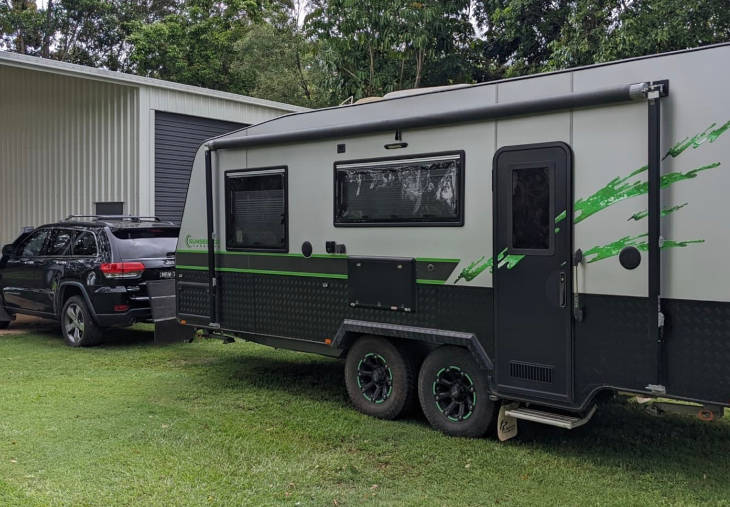
Photo credit @mobileweightcheck
If you’ve just bought your first caravan or motorhome and are planning on heading into the great outdoors, then you’re probably wondering how to hook your trundling tiny home up to an electrical supply once you get to your destination.
Unlike campervans, most caravans rely on an EHU, otherwise known as an electrical hookup system, from a campsite to get power into their leisure batteries from electrical hookup pedestals. This doesn’t cover every single caravan or trailer in the world, but you’ll generally find that this is the case with most caravan setups that you’ll come across.
Now, don’t panic; We’ve just mentioned the phrases such as leisure batteries and electrical hookup pedestals like they’re everyday terms, but fear not. Over the course of this beginner’s guide to caravan electrical hookup, you’re going to learn all there is to know about how to get electricity into your travelling home , allowing you to charge up your phone, turn on the TV and, most importantly, get that kettle boiling!
How to Get Electricity into Your Caravan
First, let’s break down some of the different components involved in your electrical system.
CEE 3-pin Electrical Hook Up Cables
Even if you haven’t used these plugs before, we can almost guarantee that you’ve seen them. These long cables have a 3-pin plug on one end and a socket on the other. The difference is where household plugs use square ended or flat pins, these ones are round.
To get electricity into your campervan, either you can charge up your leisure batteries or power your interior plug sockets directly from the campsite electricity supply, you’ll need one of these CEE 3-pin cables. Plugging them in is simple, and we’ll tell you how in the following section.
Tip: Just remember that if you’re travelling from the UK to Mainland Europe or vice versa, you might need a converter for different types of EHU posts. Most posts will be exactly the same, but just do some research before you set off so you can definitely make a brew when you get to your final destination.
Equally important is making sure to double-check your cables for any splits or tears before use and always making sure they’re dry before plugging them in. Never use a damaged cable, not even to put you on until a new one arrives.
EHU Pedestals
If you’re at a campsite, then these pedestals will be providing what we call ‘shore power’ in the camping and boating world. They bring household voltage electricity (240V UK, 220-230V Mainland Europe) into your caravan so that you can plug in devices just like you would in your house. Some pedestals require you to insert Jetons/Tokens or coins, while others work via a prepaid card from your campsite.
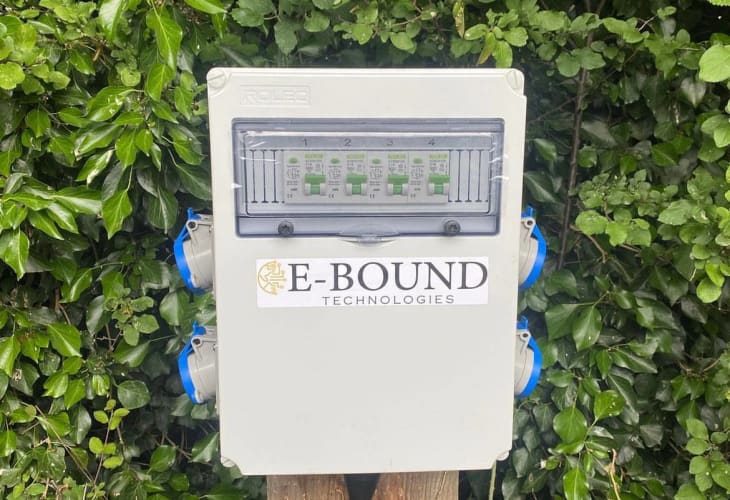
Photo credit @eboundtech
Residual Current Device & Isolator Switches Whenever household voltage is concerned, electrical safety devices must follow. Get to know the RCD units in your caravan and familiarise yourself with where they are. RCDs are the main lines of defense if an electrical device malfunctions; they’ll stop you from being electrocuted if the toaster goes haywire or something goes wrong with your kettle.
Isolator switches completely cut current flowing into your caravan. They are usually red keys that can be turned anti-clockwise to prevent electricity from flowing to your devices.
Leisure Batteries
You might have read a little bit about leisure batteries on websites while looking for the perfect caravan. In most cases, these little boxes are the hub of your electrical system. They allow you to live off grid for any amount of time, from a couple of days to a couple of weeks depending on your set up. Charge them up before you head out on the road or hook up a battery charger at a campsite to keep them topped up.
Caravan leisure batteries are usually cheaper lead-acid models as opposed to the LiFePO4 units you might see in camper vans that stay off grid for long periods of time. This is just because they don’t tend to get discharged as fully since they’re mostly hooked up to the grid at campsites or caravan parks.
Note – If you’re using EHU pedestals to charge up leisure batteries, then you’ll need a leisure battery charging device first. Make sure it can cope with your type of battery (lead-acid, gel, LiFePO4, etc.) before purchasing.
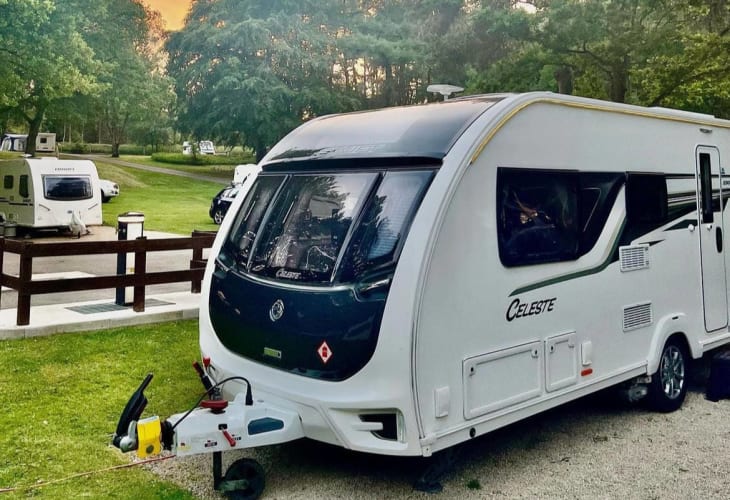
Photo credit @our.caravan.diaries
Where Do I Plug Cables into My Caravan?
CEE 3-pin plug cables have a plug with three prongs on one side and a socket with three slots on the other.
Have a look on the side of your caravan. See that little port with the three prongs sticking out of it? The socket on your cable with three slots will plug into there, and the end with the three prongs slots into the EHU post near your caravan.
Follow the steps below, and you’ll have electricity in your camper in no time.
Note: For the purposes of this section, we’re bypassing leisure batteries and going with the simplest electrical set up possible.
How to Connect to an EHU Pedestal
- Make sure your RCD and isolator switch are in the off position before you plug any cables into your caravan. If you can remove your isolator switch key, then do so and stick it in your pocket.
- Grab your CEE cable and extend it, taking care to make sure that it isn’t tightly coiled. Coiled wires can overheat, so even if the space between your caravan and your EHU pedestal isn’t very large, just run the cable back and forth a few times and make sure it’s not bundled in a tight heap.
- Plug the socket with the three slots into the side of your caravan.
- Insert the plug with the three prongs into an available slot in the nearest EHU.
- Head back into your caravan and turn your RCD on. Insert your isolator switch key back in if you removed it and turn it clockwise.
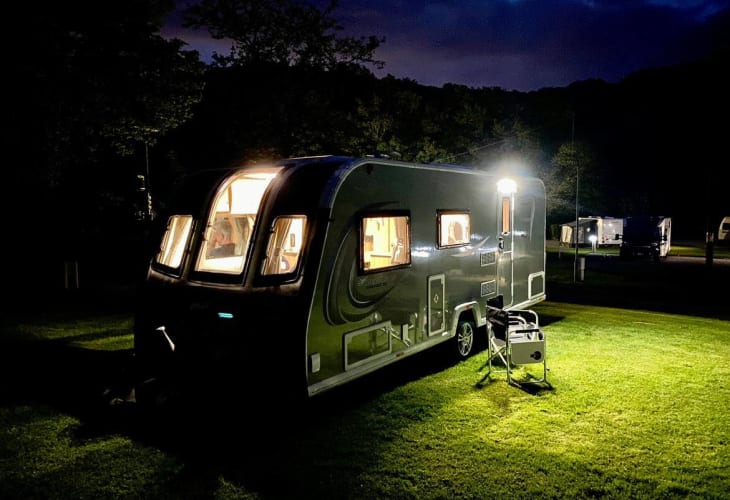
Photo credit @tin.tent
How Much Electricity Can I Use?
Campsites might provide household voltage electricity, but that doesn’t mean that you can plug in all the devices that you own at once. Amps are the official measurement of electric current, and EHU pedestals provide anywhere between 5 and 16 amps (displayed as 5A – 16A) depending on where you are in the world.
Hairdryers and kettles are two devices that you might be thinking of taking with you that will use the most amps. To check how many amps a device uses, just look on the plug; a quick look at a normal household kettle shows that it needs 13A to run.
If a campsite provides 16A, then running a household kettle at 13A and a normal hairdryer at 10A is going to be too much, resulting in the miniature circuit breaker tripping in the EHU. It’s definitely worth buying travel alternatives of the main devices you use as they require much less amperage to run, often up to 50% less than their household equivalents.
Tip: Items like phone and laptop chargers don’t require many amps at all, but it’s worth making a list of all the devices you’re planning on using and adding up the total amperage. That way, you know you’re not going to be flipping any switches in the middle of the night and trailing around in your slippers with a torch trying to figure out where the MCB switch is.
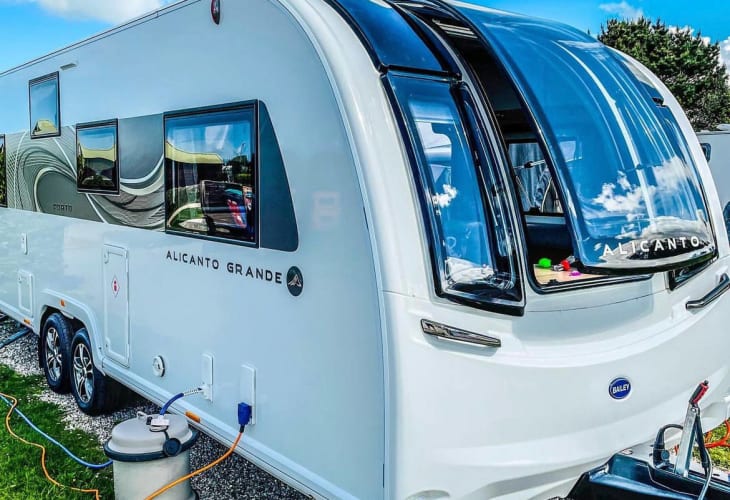
Photo credit @the_touring_boys
Obviously, this is a very simple guide to campsite electricity usage, but hopefully with our detailed instructions on electrical hookups above and a brief overview of electrical usage, you’ll now be able to get set up with ease and power your devices with zero issues. All that’s left for you to do is to enjoy the view and decide whether it’s a peppermint tea or English breakfast that’ll be brewing while you put your feet up and listen to the radio!
About the Author

Lippert guest blogger, Sebastian Antonio Santabarbara, is a thirty-two-year-old writer from Yorkshire, UK. His first breakthrough role came as the Head of Written Content for Van Clan, an online media brand documenting the van life movement with a weekly reach of over 5 million readers. This role has led to Sebastian being head-hunted to write several inspirational non-fiction books on alternative living (to be published by Frances Lincoln 2022/23) and Van Life for Dummies (published by John Wiley & Sons Sept 2022). He is also the Editor in Chief for Retro Dodo, a media/news company with a monthly reach of 1 million people. Follow his travels on Instagram!
Recent Posts
7 Best Countries for Wild CampingTop Tips for Self Van Builders
5 Best Camper Van Batteries
Common Van Life Problems and How to Combat Them
How Much Does Vanlife Cost
How to Save Space by Choosing the Right Campervan Bed Insights From Vanpuravida
5 Easy Van Life Recipes
Is Vanlife Legal?
Expert Tips for Cleaning a Campervan
Things You Need to Know When Living in a Camper
View All ›
Never miss a blog post!
Subscribe to Lippert’s blog and receive an email when a new one is posted.